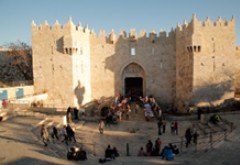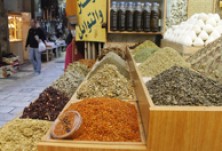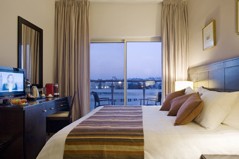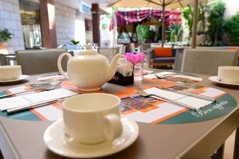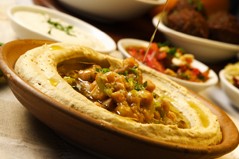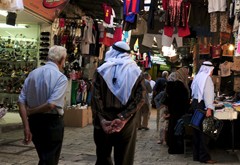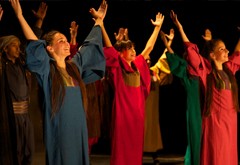The Three Suqs (al-Attarin, al-Lahhamin,al-Khawajat)
‘Travelers mentioned that they had never seen anything like these three Suqs in terms of organization and construction in any country, and that this is part of the beauty of Jerusalem.’
Mujir aDin al-Hanbali
Suq Al-Attarin
Suq al-Attarin is the middle one among the three Suqs and is also the middle of the cardo street, extending from the end of Suq Khan al-Zait until the beginning of l-Bashura, or the beginning of Harat al-Sharaf (the Jewish neighbourhood). It is recommended that visitors visit this Suq in full, given its small size. Note that this Suq is relatively narrow, and fully covered with cross-vaults, with openings in the middle for light and ventilation. When the sun’s rays pass through these vents and reflect on the colorful goods exhibited in shops, they add a poetic touch to the Suq and make passing through it an enjoyment that is worth the effort.
No Specialization in Spices
Until recently, this Suq specialized in Arabian and Oriental spices, from which it took its name. However, the quickening pace of life and Jerusalem’s openness to modernity reduced the importance and number of these shops, which are now reduced to only three. Other shops exhibit various types of goods, particularly cloth and shoes. The variety and colors of offered goods gives the Suq an oriental bazaar touch.
Pathway between the Three Suqs
A path in the middle of Suq al-Attarin connects the three Suqs, and instead of crossing the whole Suq to reach the next one, one can cross to parts of the other two Suqs, namely, Suq Al-Lahhamin, parallel to the west, and part of Suq al-Kahawajat, parallel to the east.
Suq al-Lahhamin (Butchers’ Market)
This Suq comprises a large number of shops selling meat and vegetables. Half a century ago, many of these shops specialized in Arab, traditional blacksmithing, using hammering and blowing, as well as copper and other metal works. A group of local artisans, particularly Armenians, excelled in whitewashing copper utensils and cooking pots, and the Suq was often referred to as Suq al-Nahhasin (coppersmiths).
Suq al-Khawajat (Well-Off Market)
The eastern section of the Suq is known as Suq al-Khawajat, referring to traders of cloth and textiles. At present, only the southern part of the Suq is open, as the northern part requires renovation after large parts of it caved in following the 1927 earthquake. The result of this is referred to as al-Sabra (Cactus), which is an Islamic Waqf for the Nusayba family, and is targeted by Zionist and other settlement organizations that want to make this land an extension of the Jewish Quarter south of it.
Architectural Fabric and Origin of the Suqs
The architectural history of these three Suqs dates back to the Ayyubid era. Some of the Suqs’ foundations may go farther back to Roman times, with some renovations in the Crusader era, done, as seen by archaeological excavations, on the lines and foundations of the Roman and Byzantine Suqs. The three Suqs are covered with cross-vaults, with openings for light and ventilation. Their floors are paved with the famous Jerusalemite stone tiles mentioned by Nasir Khusrau, who visited the city during the Fatimid era in the 5th century AH. Mujir al-Din also mentioned the three Suqs, saying: ‘The three Suqs were built by the Romans, extending from south to north, and have exits towards each other. The first is Suq al-Attarin, endowed to Waqf by Salah al-Din… ,to serve as his Salahiyya school, the second Suq is for selling vegetables, and the third to the east is for cloth and textiles, with the last two Suqs endowed to the Waqf of the Noble al-Aqsa Mosque.’

